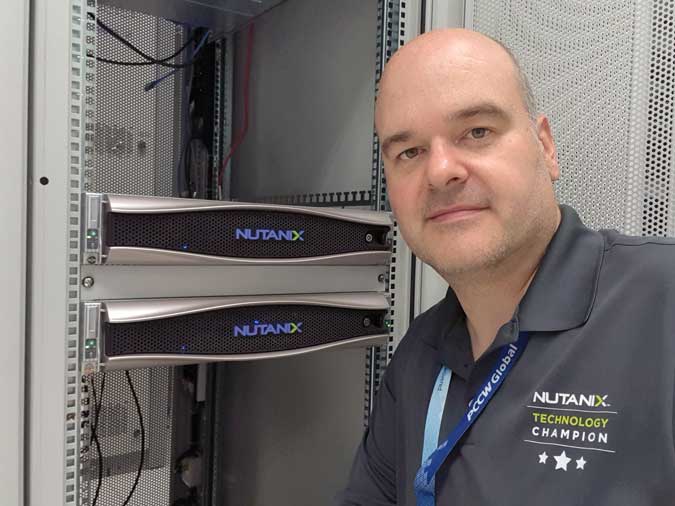Little things can spark big changes, especially in the fast-moving world of cloud computing. It happened to Frederic Lhoest, a senior technology architect for global telecom services provider PCCW Global, when he was searching online for technology that could help his company. He quickly found videos and customer case studies that showed how quick and easy it was to create a private cloud inside his company’s data center. What once seemed laborious, time consuming and almost impossible turned out to be a cinch with hyperconverged infrastructure from Nutanix.
In 2014, Lhoest was asked to research the best way to deploy a private cloud inside PCCW Global. He turned to the internet post haste. After all, that’s where he stays informed, communicates with IT communities and shares knowledge on his Let’s Talk About Tech blog.
“I will never forget the night I found the Nutanix YouTube channel,” he said. “I spent the whole night looking at videos on the channel. I was so amazed by the simplicity of them and it was a key changer for me.”
From those videos and case studies, Lhoest quickly learned what it took to bring hyperconverged infrastructure (HCI) into his IT ecosystem. He learned how HCI combines common data center hardware using locally attached storage resources with intelligent software to create flexible building blocks that can replace legacy infrastructure consisting of separate servers, storage networks, and storage arrays. Lhoest knew these private cloud capabilities could help PCCW Global more easily and quickly scale to meet the increasing demands of digital workloads.
Some might see it as a sign of the times, as most people now rely on the internet for the latest information to help make important decisions and big purchases. For decades, consumers have gone online to find their next home, car or career. The same is true for businesses that once relied on consultants and salespeople visits but can now find new enterprise products and services online. In a world that’s increasingly powered by software and cloud computing, company insiders like Lhoest can scale operations with a few clicks of a mouse.
With growing excitement and resolve, Lhoest knew he had to show —not just tell — his team about his discovery. He knew that test driving a Nutanix-powered hyperconverged cluster was the way to demonstrate to internal stakeholders how hyperconverged infrastructure worked.
“I convinced management to get the smallest Nutanix cluster that we could do at that time,” he said. “Little by little, my technical colleagues fell in love with it. Little by little, we managed to get another cluster, which became the first production cluster in Hong Kong.”
The ease of use of the system is what convinced his colleagues it was the right solution.
“We have so many things to deal with and we’re such a small team, so Nutanix allows you to be up and running quickly because it is very easy to use. In a few clicks, you can achieve very complex tasks.”
Senior IT architect Frederic Lhoest in front of PCCW Global’s first production cluster in Belgium, a Nutanix 6000 series with 3-nodes.
After his team embraced the pilot, PCCW Global moved quickly to leverage HCI across the company.
“We decided to move forward with another cluster in the UK, then in the U.S., and now we have seven clusters,” he said. “That equates to almost 1000 virtual machines with replication across continents. Last year, our company decided to establish our internal IT strategy around Nutanix.”
Today, PCCW Global’s data centers are 85-90% converted to Nutanix, Lhoest said.
“That is impressive because if you look back two years ago, the speed (of adoption) is incredible. Two years ago, I would never have bet we would be this far.”
He said the company is looking to bring new capabilities to help manage security, containers and virtual desktops for remote workers.
Community
The how-to videos and case studies are still critical to Lhoest and his team’s success. He said the content and active online community enable IT pros to self-manage systems.
“Nutanix is providing all the tools we need to do this transformation,” he said. “They provide professional services that can assist you in the transformation.”
Especially in the age of COVID-19, humans need relationships, which drove him to join the Nutanix Technology Champions (NTC) community, where experts share tips and answer questions quickly on a Slack channel.
“We are doing things like exchanging contact info, asking for access to better versions or resources, or we can get in touch directly with a Nutanix PM,” he said. “It’s a great place to get answers to questions. Knowledge is nothing if it is not shared.”
Looking Forward
He said the pandemic showed that the IT world evolution toward virtualization and automation meets the need organizations have to self-manage their systems.
“Machine learning will take a bigger place in automation. Because today, automation is reacting to a trigger, and the trigger is coded in the automation script. Tomorrow, maybe the triggers will be generated on the fly by AI automation.”
That future is in the making, but Lhoest sees enterprise cloud computing evolving rapidly. Things keep getting more powerful, quicker and easier to use.
“Today, we have virtual machines, but if you look back 10 years ago, there were a lot of physical servers. To deploy a new service, you’d need to buy a server and get it delivered. Now, it is completely different. You just need a marketplace and few clicks and the server is ready.”
Brian Carlson is a contributing writer. He is Founder of RoC Consulting and was Editor-in-Chief of CIO.com and EE Times. Follow him on Twitter @bcarlsonDM
© 2020 Nutanix, Inc. All rights reserved. For additional legal information, please go here.



